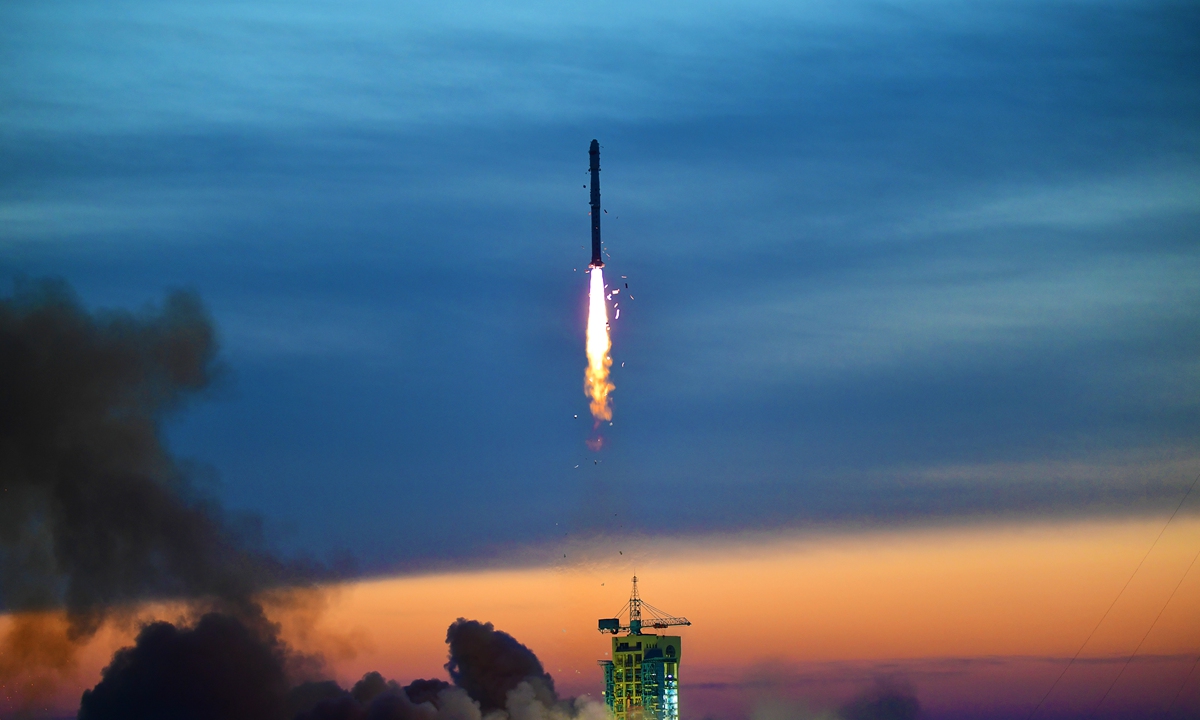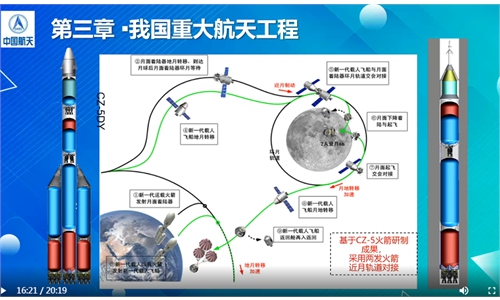SCI-TECH / AIR & SPACE
China’s Long March family accomplishes 4th 100 launches with unprecedented speed

A Long March-4B rocket carrying the Shijian-6 05 satellites blasts off from the Jiuquan Satellite Launch Center in Northwest China, on December 10, 2021. Photo: Xinhua
With an unprecedented speed, China's indigenous Long March rocket family has recently accomplished its fourth 100 launches with 33 months, manifesting high frequency space launch missions by the series has become a new normal and the rapid growth of the country's comprehensive strength and advancement of its science and technology, developers and industry analysts hailed on Sunday.
The milestone launch mission was carried out by a Long March 4B carrier rocket on Friday morning, which ferried Shijian 6-05 satellites into designated orbit. From the launch of Tianlian-2 -1 relay satellite via the Long March 3B to the Friday mission, it took less than 3 years for the Long March rocket family to nail the fourth 100 launches, renewing the fastest record in the country's aerospace history.
Over the past 51 years, since the first flight of Long March-1 in 1970, Long March carrier rockets have been deployed in an overwhelming majority - 92.1 percent of China's space launches.
According to the rocket developers with the state-owned space giant China Aerospace Science and Technology Corporation (CASC), the first 100 launches took place over 37 years, but then things started to heat up: the next 100 took seven and half years, the third took four years and three months, and the fourth only took two years and nine months.
The new milestone of Long March rocket family did not come easily, space industry analysts said on Sunday, pointing to the fact the recent two years, the global space development has inevitably been affected by the still ongoing pandemic.
"The primary reason behind the resilience of China's Long March family amid the pandemic is that it is equipped with fully domestically-built and controllable technology," Song Zhongping, a space analysts and TV commentator, told the Global Times on Sunday.
Besides speed, it is also worth noting that in the recent 100 launches, the Long March rockets has pulled off quality missions in the period including the launch of China's Tianhe space station core module, Shenzhou manned spacecraft, Chang'e-5 lunar probe and the country's first interplanetary Tianwen-1 Mars exploration mission.
CASC developers hailed in a statement it sent to the Global Times that the fourth 100 launches marked a new starting point for China's aerospace industry's moving from quantitative change to qualitative change, and an important milestone for China to fully start building a space power nation.
The China Academy of Launch Vehicle Technology (CALT,) a subsidiary of the CASC and the major contractor and designer of Long March rocket family, revealed to the Global Times that next the academy will continue work on the development of two types of heavy-duty carrier rockets that are even more powerful than the currently strongest model of Long March-5 to support future crewed flight mission to the moon and to send large probes to deep space.
Temporarily referred as the new-generation manned rocket, it will be a 90-meter-tall three-stage model with an escape tower on the top. It will posses some 2,000 ton weight-at-launch and be capable of sending payload of 25 ton to the lunar transit orbit, or payload of 70 ton to the new-Earth orbit. It is tasked to fill in a blank space of the country's crewed lunar probe capability, according to the CALT.
The other new model will be the 100-ton level heavy-lift carrier rocket, which is under the CALT development and is expected to take maiden flight by 2028. It is capable of sending payload up to 140 ton to the near Earth orbit and pay load up to 50 ton to the lunar transit orbit or maximum of 44 ton to the Mars transit orbit, the academy revealed.
While blocking any cooperation and exchange with China's space industry through legal instruments, the US is hyping about China's space robust progress with malicious intention, analysts said.
On a panel of US space experts and leaders speaking at the Reagan National Defense Forum, General David Thompson, vice chief of space operations for the US Space Force, said Saturday China is developing its space capabilities at "twice the rate" of the US, the CNN reported on December 6.
"If we don't start accelerating our development and delivery capabilities, they will exceed us," Thompson said, adding, "2030 is not an unreasonable estimate."
The US Space Force and NASA have been overestimating and selling the idea of China-threat in space to serve the purpose of consolidating its dominance in space, Song said, noting the large gap is still admittedly there, be it in the manned space field or the satellite application area.
China needs to steadily follow its own planned pace and neglect the US hype in developing its own space strength, while heeding not to fall in the trap of space arms race and the US long-pursuit of militarizing the space, Song warned.
On the contrary to the US exclusiveness, China's space has been always making good to the world. Data provided by the CASC shows that the Long March rocket family has provided special launch service just for international clients for 52 times, sending 69 commercial satellites into orbits.
The CASC has also established cooperation with 30 countries and regions as well as international organizations in the domain of commercial space, among which 15 are countries along the route of China-proposed Belt and Road Initiative.


